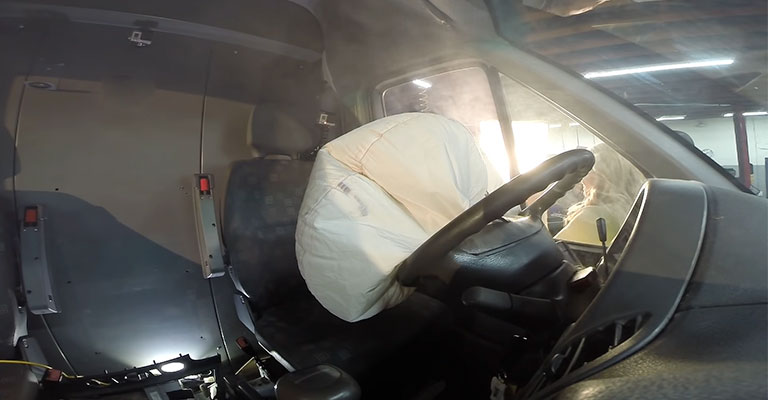Airbags of a vehicle work as a protector when the vehicle engages in any type of collision. Often, vehicle owners are not familiar with the airbag deployment process, and this leads to a common query about what happens when airbags deploy.
Generally, an airbag fills up with air after deploying. When a vehicle engages in a collision, it acts as a barrier between the driver and the steering to reduce the possibility of injuries.
By the end of this article, you will know about the airbag deployment process along with the risks and risk prevention tricks associated with it.
What Happens When Airbags Deploy?

Almost every vehicle has two types of airbags, both for the driver and the passengers. Usually, the driver’s airbag and the passenger’s airbag are located in different locations in the vehicle, and they also vary in size.
The driver’s airbag is located in the steering, so it is comparatively smaller. On the other hand, the passenger’s airbag has to cover a huge space between the backseat and the front seat. So, it is larger and contains more air than the driver’s airbag.
In some vehicles, an additional airbag is attached to the vehicle door. This airbag is deployed to prevent any crash impact that might come from the sides.
Basically, the airbag deployment process occurs with the help of a crash sensor. If a vehicle is engaged in any crash or collision, the crash sensor triggers the igniter of the vehicle. As a result, the igniter produces a gas that fills up the airbag.
Most of the igniter produces either nitrogen or argon gas for filling the airbags.
It takes a very short time to deploy an airbag completely. Generally, 1/20th of one second is required for the deployment process, which ensures a quick and efficient solution against accidents.
Are Airbags Safe?

Suppose you are going on a drive, and suddenly your car crashes into a barrier on the road. The momentum of the vehicle will give rise to high inertia, for which you will be dragged in the front direction.
In such a situation, there is a huge possibility that you will hit the windshield or other hard metal parts of the vehicle. This can lead to face and head injuries which can be severe in case of injuries to other body parts.
Basically, airbags are installed in vehicles to ensure the highest protection against crashes and collisions. They are like protection shields for vehicles.
Airbags are proven to lower the rates of injury in multiple areas of your body. The front, center, side, and rear seat airbags work combinedly to ensure the highest safety. Besides, the inflatable seat belts also work as optional safety gear along with the airbags.
If your vehicle crashes into any barrier on the road, the crash sensors will initiate the airbags to fill with air in a short moment. As a result, you will hit the airbag instead of the windshield of your car.
As the airbag is made of light fabric, a minimal force will impact your body, which can save you from a severe accident. Besides, the airbags will also prevent you from being ejected from the car during any accident.
Risks Related to the Airbag Deployment Process

Though airbags are safety shields of a vehicle to protect you from any severe accident, they might not guarantee your protection all the time because of certain issues.
In some situations, the airbag deployment process can be harmful also. So, there are a few risks related to the airbags, as the deployment process might go wrong in some cases. The possible risks related to the airbags are stated below.
Crash Sensor Failure
The most dangerous thing that can happen to the airbag deployment process is the failure of the crash sensor.
If the crash sensor doesn’t work well, it can’t detect any collision of the car. As a result, the airbag will not deploy and cause severe accidents that can be dangerous to the passengers and the vehicle.
Chemical Residue
As airbags are mostly made with nylon fabric, it is coated with different chemical residue near the steering.
When the airbag is filled with air and inflates with a high force, the chemical residue spreads around. It can cause breathing difficulties and many other respiratory issues.
High Inflation Force

The airbag deployment process can impact a high force during sudden inflation at the speed of around 200 mph. This inflation force can cause mild to severe injuries to your face and chest.
If you remain close to the steering when the airbag is deploying, it can result in severe fractures also.
Release of Dirt Particles
Often, dirt particles might gather around the steering, which scatters around during the airbag inflation. If the dust particles scatter, you can experience asthma attacks and breathing problems.
Frequently Asked Questions
- Is it safe to drive without airbags?
Because of the risks related to airbags, people often tend to drive without airbags. But it can be too dangerous. So, it is necessary to drive with airbags to ensure the safety of the driver and passengers.
- What to do after the airbag deployment process?
After the airbags deploy in your car, check if there are any injuries or not. Turn off the engine and take the vehicle to a technician for proper inspection. Finally, replace the airbags of your vehicle with new ones.
- Do airbags cause injuries to your body?
Airbags might cause small to medium injuries to your body due to the high inflation force. Besides, the powder residue coated around the airbags can also cause respiratory problems.
Final Words
Though airbags are installed in vehicles to save lives during accidents and reduce the possibility of injuries, there remain some obvious risks associated with them. If you know what happens when airbags deploy, you can easily prevent these risks by staying conscious.
Hopefully, this article made all the facts clear about the airbag deployment process. Maintain your vehicle well and always drive with the airbags to remain safe from any accidents due to crashes and collisions.
Leave a Reply